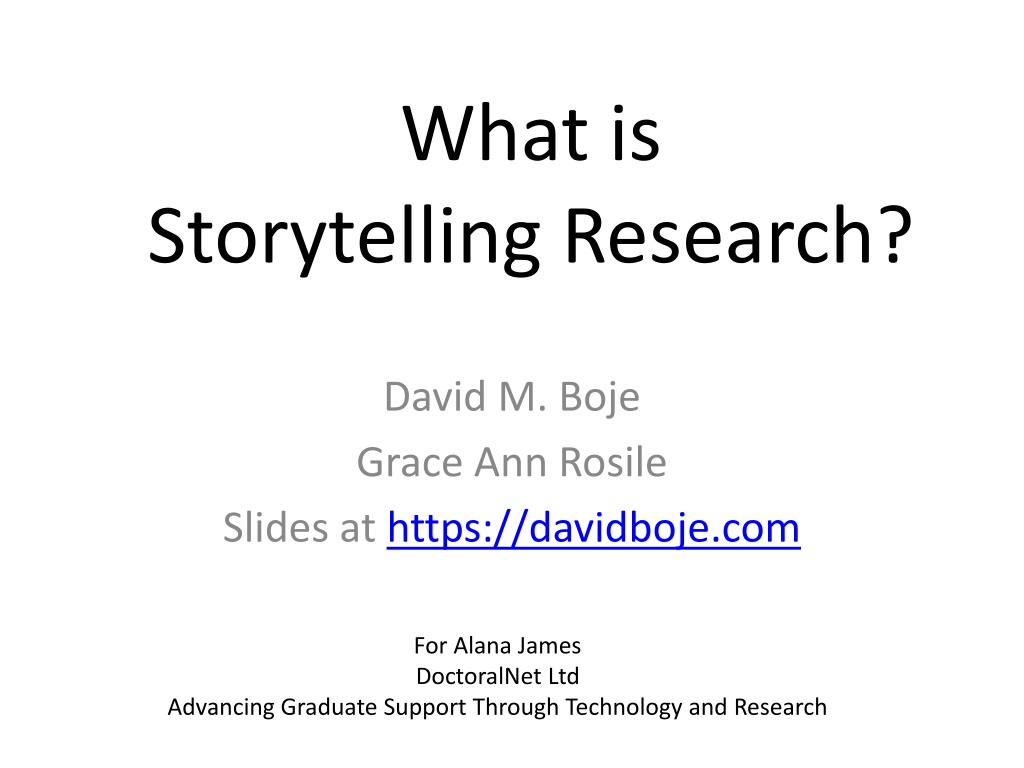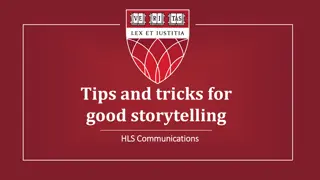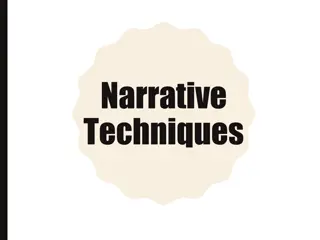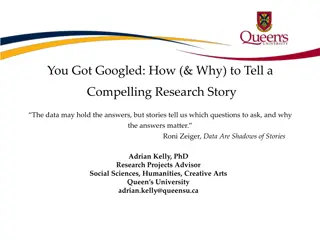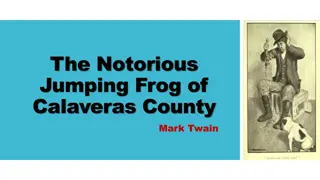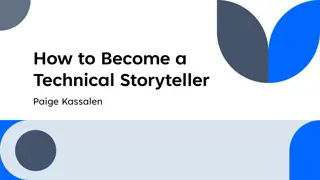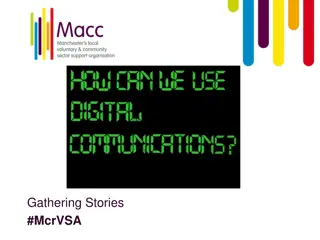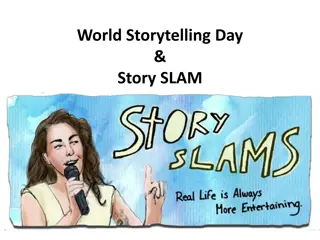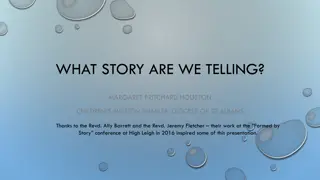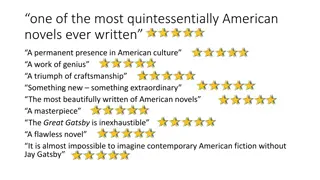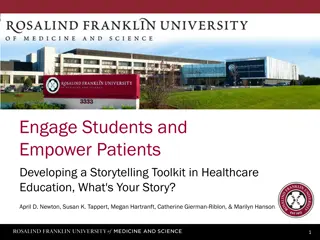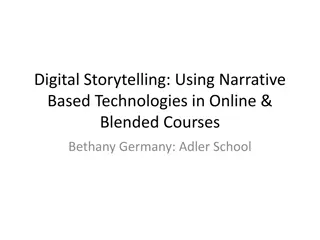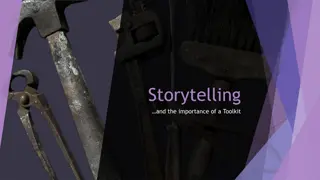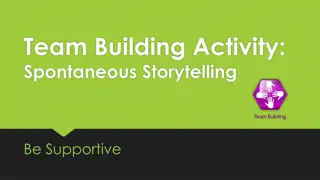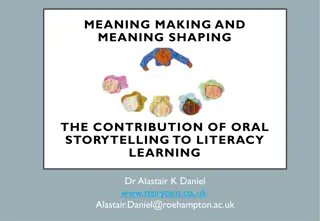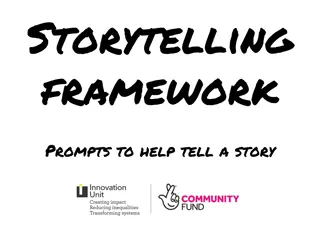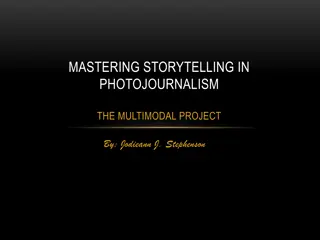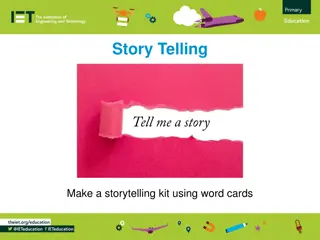Understanding Storytelling Research: An Overview
Storytelling research delves into narratives, counternarratives, living stories grounded in time and place, and antenarrative processes. It explores the concepts of storytelling as Tamara-Land, antenarrative, and a science. The intersubjectivity of storytelling unfolds through untold stories and conversational dynamics, emphasizing the nuances of narrative abstracting. This overview provides insights into the multifaceted nature of storytelling research.
Download Presentation

Please find below an Image/Link to download the presentation.
The content on the website is provided AS IS for your information and personal use only. It may not be sold, licensed, or shared on other websites without obtaining consent from the author. Download presentation by click this link. If you encounter any issues during the download, it is possible that the publisher has removed the file from their server.
E N D
Presentation Transcript
What is Storytelling Research? David M. Boje Grace Ann Rosile Slides at https://davidboje.com For Alana James DoctoralNet Ltd Advancing Graduate Support Through Technology and Research
What is Storytelling? Storytelling includes three facets: 1. Narratives & Counternarratives 2. Living Stories Grounding in place & time 3. Antenarrative Processes For now Antenarrative means BEFORE (narratives or story) and BETS on the Future
What is Storytelling Research? It does not start with the BME Story although it may show up later It does start with 3 concepts: 1.Storytelling as Tamara-Land 2.Storytelling as Antenarrative = 6 B s 3.Storytelling as science
Antenarrative Intersubjectivity The untold story (Hitchin, 2015)
WHAT IS INTERSUBJECTIVITY OF STORYTELLING? 1. Walking the Stairs story 2.Boss s New Couch Office Supply Study (Boje 1991)
WHAT IS INTERSUBJECTIVITY OF STORYTELLING? Conversational Storytelling Sound of footsteps David: Ok, how can I help you? (Softly asked) Grace Ann: I m going to give him his second. So that s his (points to one plastic tub) David: OK Grace Ann: And there s a bowl, outside for now [more footsteps; sound of food being poured into the bowl] See that bowl there David: OK? Grace Ann: We keep them separate (scuffling sound) that s all right, let him go, he s going to go with you. 10
Sound of footsteps David is in his home office in Las Cruces David: Ok, how can I help you? (Softly asked) Grace Ann: I m going to give him his second. So that s his (points to one plastic tub) Grace Ann walks in the office, interrupting David s usual writing, with Sparkles who usually eats there in that office. The new puppy from the Rescue Shelter is about to get first meal in our home (Before). The new dog gets his food second to reinforce to the old dog that she is now the senior dog, she knows the rules, and the new dog should respect her and follow her lead David: OK David agreeing, to show he has heard. There is history here (Before), since it is about how Sparky and Honey had been fed in separate rooms before Sparky died. Then Honey was alone, and then later when Sparkles came, Honey became top dog and was fed first. After Honey was gone, Sparkles was alone until the new male puppy was adopted. Now Sparkles is top dog and gets to eat first, and the new puppy is second in rank. This is (Rehistoricizing) the dog-to-dog relationship. Grace Ann: And there s a bowl, outside for now [more footsteps; sound of food being poured into the bowl] See that bowl there 11 (Futuring) Giving her plan (Foretelling bets on
Coalition of Immokalee Workers (CIW) ending Modern Day Slavery with Worker-Driven Corporate Social Responsibility 14
Embodied Restorying Intervention The Cheating case example
Steps of the Embodied Restorying Process: 1. Characterize: Describe you at your best. What would a favorite grandparent, parent, teacher, family member, or best friend, say about you? These received narratives constitute a received self-identity. For example, society, films, families, and institutions such as the military or professional training all tell us who we should be and how we should behave. 2. Externalize: Describe your old story, and make any problems or struggles into another character in your story (use an object in the sand tray to describe this character/problem). (Note: some people prefer to talk about their old story before they describe their best self. 3. Sympathize: How has the problem (the old story) benefitted you or how is it understandable? 4. Revise: Identify negative consequences of the problem. This helps reaffirm the commitment to change them. 5. Strategize: Find the little wow moments of exception to the usual same old story. For example, How did you overcome the problem this time? 6. Restory: Re-write history and write a new future story. This time, highlight all the little wow moments and make them the new normal (instead of the exception) in the future story. 7. Publicize: Identify a support network and write letters to potential supporters to request participation in the new story of the future. It does not matter if the letter recipients respond or not. Consider family and friends who can support and call you on it if the old story creeps back in.
Your Questions 1. How do you triangulate data when building out a storyline? Triangulation too often lets quantitative marginalize qualitative, but makes its points with the qualitative excerpts; we recommend self-correcting methods over triangulation (ask GA for hospital maternity ward case) Use Abduction, and let the story emerge. Based on what emerges, you can observe something & use Induction to draw a conclusion which can be tested (boss throws coat on secretary s desk; are all bosses arrogant?). Deduction: General belief that secretaries/subordinates should help the boss with less-challenging work
Your Questions 2. What are the three things that are most important when bringing my data together to tell a story? 1. Let people speak in their own voices; it is their story and their data, not yours. 2. Explain the contexts (6 B s of Antenarrative) 3. Identify patterns in both process & content (i.e. process: the boss always speaks first/ Content: the boss assigns the tasks)
Your Questions 3. How does the storyline relate to the publication? Is it like an outline? A. At least 2 elements of the research process should be addressed in your final article: 1. Autoethnography: self-reflection on how you as researcher have influenced the process, 2. Self-reflection with self as subject, how the topic has changed you. B. Publications need to follow the format required by the particular journal
Your Questions 4. Where do you start? Something catches your attention Abduction, You wonder how to test it Induction, and You develop a theory of conclusions from premises Deduction
Questions and Discussion Download for free until published in 2020 Download free till published Slides at https://davidboje.com 25
